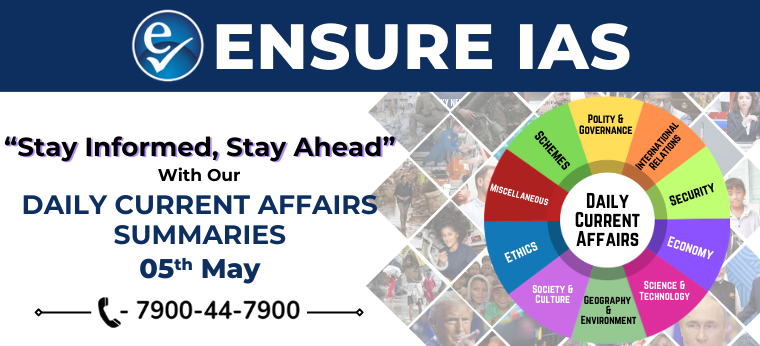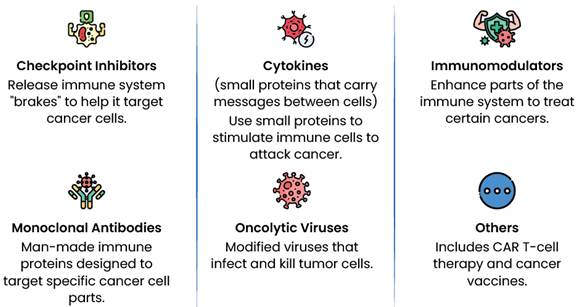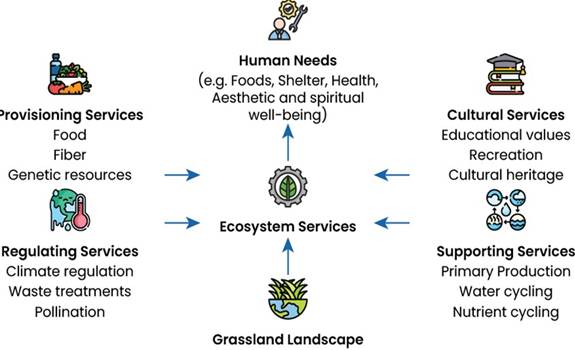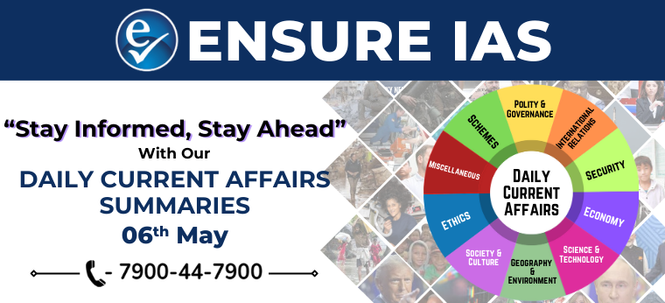- Courses
- GS Full Course 1 Year
- GS Full Course 2 Year
- GS Full Course 3 Year
- GS Full Course Till Selection
- Answer Alpha: Mains 2025 Mentorship
- MEP (Mains Enrichment Programme) Data, Facts
- Essay Target – 150+ Marks
- Online Program
- GS Recorded Course
- Polity
- Geography
- Economy
- Ancient, Medieval and Art & Culture AMAC
- Modern India, Post Independence & World History
- Environment
- Governance
- Science & Technology
- International Relations and Internal Security
- Disaster Management
- Ethics
- NCERT Current Affairs
- Indian Society and Social Issue
- NCERT- Science and Technology
- NCERT - Geography
- NCERT - Ancient History
- NCERT- World History
- NCERT Modern History
- CSAT
- 5 LAYERED ARJUNA Mentorship
- Public Administration Optional
- ABOUT US
- OUR TOPPERS
- TEST SERIES
- FREE STUDY MATERIAL
- VIDEOS
- CONTACT US
Daily Current Affairs Summary 5th MAY 2025
Daily Current Affairs Summary 5th MAY 2025

Mitochondrial DNA (mtDNA)
- Scientists have identified a small molecule named PZL-A that targets a crucial mitochondrial enzyme.
- This discovery offers hope for treating rare inherited disorders caused by mutations in mitochondrial DNA (mtDNA).
What is Mitochondrial DNA (mtDNA)?
- Mitochondrial DNA (mtDNA) is a small, circular chromosome found inside the mitochondria, the cell's energy-generating organelles.
- Unlike nuclear DNA, mtDNA is located outside the cell nucleus, within the mitochondria.
What Makes mtDNA Unique?
- Mitochondria are the only organelles in human cells that carry their own genetic material, separate from nuclear DNA.
- mtDNA is maternally inherited, meaning it is passed down only through the mother and not from the father.
How is mtDNA-related Disease Treated?
- Mitochondrial Replacement Therapy (MRT) is used to replace faulty mtDNA with healthy versions.
- MRT can be performed either before or after the process of in vitro fertilization (IVF).
- This method helps prevent the transmission of mitochondrial diseases to the next generation.
Cancer Patients in UK to Receive Immunotherapy Drugs via Single Injection for Faster Treatment
- The UK has introduced a faster method of administering Nivolumab, an immunotherapy drug, via a 15-minute injection, replacing the traditional hour-long intravenous (IV) drip.
- This new method is aimed at providing quicker treatment for cancer patients.
About Immunotherapy
- Definition: Immunotherapy is a type of biological therapy that utilizes the components of a person's immune system to fight diseases like cancer.
- Biological Therapy: Involves using substances derived from living organisms to target and treat cancer.
- Chemotherapy: In contrast, chemotherapy targets cancer cells directly but may also harm healthy cells.
How Immunotherapy Works
- Stimulating the Immune System: Immunotherapy encourages the immune system to work harder or smarter in recognizing and attacking cancer cells (e.g., Immunomodulators).
- Creating Immune System Components in a Lab: This method restores or enhances the immune system’s ability to find and destroy cancer cells (e.g., Monoclonal Antibodies).

Types of Immunotherapies
Advantages of Immunotherapy
- Precise: Targets cancer cells while sparing healthy cells.
- Dynamic: The immune system can adapt, launching new attacks if a tumor evades detection.
- Remembers: The immune system’s memory allows it to recognize and eliminate recurring cancer.
Disadvantages of Immunotherapy
- Less Effective: It is less effective for tumors with immune suppression and immune exclusion due to high selectivity.
- Variable Effectiveness: Its effectiveness varies, leading to uncertain patient survival rates and prognosis.
- High Costs: Immunotherapy treatments are often expensive.
Government of Karnataka Notifies Hesaraghatta Grassland Conservation Reserve
The Government of Karnataka has notified the Hesaraghatta Grassland Conservation Reserve under Section 36A of the Wildlife Protection Act (WPA) 1972.
Conservation Reserve: Key Details
- A Conservation Reserve is considered a protected area under the Wildlife Protection Act (WPA) 1972.
- It can be declared by both State and Central Governments to protect landscapes, seascapes, flora, and fauna.
- These reserves typically act as buffer zones or connectors and migration corridors between established national parks, wildlife sanctuaries, and protected forests.
- The Conservation Reserve Management Committee, appointed by the state government, advises the Chief Wildlife Warden on the management of the reserve.

About Hesaraghatta Grassland
- Hesaraghatta Grassland is located around Hesaraghatta Lake near Bengaluru, Karnataka, and is the last remaining grassland habitat in the Bengaluru region.
- Grasslands are open regions dominated by grasses, typically characterized by a warm, dry climate.
- They are one of the most widely distributed terrestrial biomes, covering 20-40% of the global land area and about 24% of India’s geographical area.
- Globally, grasslands are classified into Tropical Savannas, Temperate Grasslands, and Steppes.
Significance of Hesaraghatta Grassland
- The grassland is an important biodiversity reservoir, home to species like leopards, Indian foxes, smooth-coated otters, and migratory birds.
- It plays a crucial role in reviving groundwater levels and acts as a sponge to soak up monsoon runoff.
- It serves as a large catchment area for the Arkavathy River, Thippagondanahalli Reservoir, and Hesaraghatta Lake.
Prime Minister's Inauguration of Projects in Amaravati, Andhra Pradesh
- The Prime Minister inaugurated infrastructure projects worth ₹58,000 Crore in Amaravati, the capital city of Andhra Pradesh.
- Key projects include the Legislative Assembly, High Court, and Secretariat, laying the foundation for the city’s development.
- The PM also laid the foundation for the Navdurga Testing Range at Nagayalanka, AP, which will be used for missile testing.
About Amaravati (Capital of Andhra Pradesh)
- Amaravati is a greenfield city located along the Krishna River, in Guntur District.
- The capital project began in 2014, following the bifurcation of Andhra Pradesh and Telangana.
Buddhist Legacy of Amaravati
- The Amaravati Stupa, dating back to the 2nd Century BCE, is one of the oldest Buddhist monuments in India and referred to as the Maha Chaitya (The Great Stupa).
- Amaravati is believed to be the place where Gautam Buddha first spread his teachings of the Kalachakra (Wheel of Time).
- Acharya Nagarjuna, a prominent figure in Mahayana Buddhism, is said to have lived in the Amaravati region and propounded the Madhyamika philosophy.
- The Chinese pilgrim Xuanzang visited Amaravati in the 7th century to collect sacred Buddhist texts.
Other Historical Legacy of Amaravati ("The Place for Immortals")
- Satavahana Capital: Amaravati served as the capital of the Satavahana Kingdom from the mid-1st to early 3rd century AD.
- Sri Amaralingeswara Swamy Temple: A medieval Shiva temple located in the region.
- Amaravati developed a distinct art style, on par with the Gandhara and Mathura art styles.
Features of the Amaravati School of Art
- Narrative Style: Amaravati art depicts stories from the Buddha’s life with dynamic medallions, featuring expressive and energetic carvings.
- Naturalism: The art is known for its realistic portrayal of scenes, making it visually engaging.
- Architectural Elements: Art can be found on parts of Buddhist stupas, including railings and plinths.
- Material: The art was crafted from a white, marble-like stone, enhancing its detail and visual appeal.
- Example: The Buddha statue at Nagarjunakonda is a prominent example of the Amaravati art style.
Initiatives for Ageing with Dignity
- The President of India launched initiatives aimed at the welfare of senior citizens during the event "Ageing with Dignity - Initiatives for the Welfare of Senior Citizens."
- The key initiatives launched include:
- Senior Citizen Welfare Portal: A digital platform providing elderly citizens with easy access to government schemes, healthcare benefits, and welfare services.
- Senior Citizen Homes: These homes are supported under the Ministry of Social Justice & Empowerment’s programme, in alignment with the Maintenance and Welfare of Parents and Senior Citizens (MWPSC) Act.
- MoU with Brahma Kumaris: This agreement aims to promote emotional balance, mindfulness, and intergenerational bonding among senior citizens.
RBI-Regulated Markets
- The RBI Working Group has submitted a report reviewing the trading and settlement timings of markets regulated by the Reserve Bank.
- The RBI regulates various markets under several legislations, including:
- RBI Act 1934
- FEMA 2000
- Government Securities Act 2006
- Payments and Settlement Systems Act 2007
- The regulated markets include:
- Money Market, comprising segments like call money, market repo, and TREP.
- Government Securities Market, which includes dated securities, T-Bills, and State
Government Securities.
-
- Foreign Exchange Market, covering spot, forwards, swaps, and more.
- Derivative Markets, focusing on interest rates, foreign exchange, and credit derivatives.
Triple Test for OBC Quotas in Local Bodies
- The Triple Test was outlined in the Vikas Kishanrao Gawali vs State of Maharashtra case (2021).
- Jharkhand has taken the first step by collecting data on the population of Other Backward Classes (OBCs), which is part of the Triple Test process.
- The Triple Test consists of three steps:
- Establish a dedicated Commission to conduct a thorough empirical inquiry into the nature and implications of backwardness in local bodies.
- Based on the Commission's recommendations, determine the proportion of reservation required for OBCs.
- Ensure that the combined reservation for SCs, STs, and OBCs does not exceed 50% of the total seats in local bodies.
Bioswales: A Nature-Based Solution for Stormwater Management
- Bioswales are shallow, vegetated ditches designed to capture and filter stormwater runoff.
- These structures serve multiple purposes, including controlling erosion, reducing pollutants, and promoting groundwater recharge.
- They are typically filled with native plants, gravel, and sand to enhance water filtration.
- Bioswales offer significant benefits such as improving stormwater management, reducing flooding, and promoting local biodiversity.
- Commonly found in urban areas, they help manage runoff from roads, parking lots, and rooftops.
- The size, shape, and depth of bioswales can vary depending on the specific area and rainfall patterns.
Ramman Festival: A UNESCO-inscribed Cultural Heritage
- The Ramman Festival is celebrated annually in the twin villages of Saloor-Dungra in Uttarakhand, during late April, after the harvest season.
- It holds great religious significance as a tribute to Bhumiyal Devta, the village's tutelary deity.
- The festival features complex rituals including the recitation of a version of the epic Ramayana.
- Another important aspect of the festival is the performance of traditional songs and masked dances.
- Jagar, a musical rendition of local legends, is sung during these performances, adding to the festival's unique cultural essence.
- The Ramman Festival is inscribed on the UNESCO Representative List of the Intangible Cultural Heritage of Humanity, highlighting its cultural importance.
Opinion trading platforms
The Securities and Exchange Board of India (SEBI) has cautioned investors against dealing with opinion trading platform.
About Opinion trading platforms
- Concept: These platforms allow participants to earn money by investing in their predictions on any sports, political, weather, or crypto events,
- Participants can bet on any event based on their predictions.
- If the predictions are correct, a participant makes money, and in case the prediction goes wrong they lose.
- Legal Status: not regulated by SEBI because the items being traded are not classified as securities under Indian law.
- Economy: These platforms have registered transaction volumes of over Rs 50,000 crore a year with a user base of more than 5 crore people.
|
Also Read |
|
| FREE NIOS Books | |




